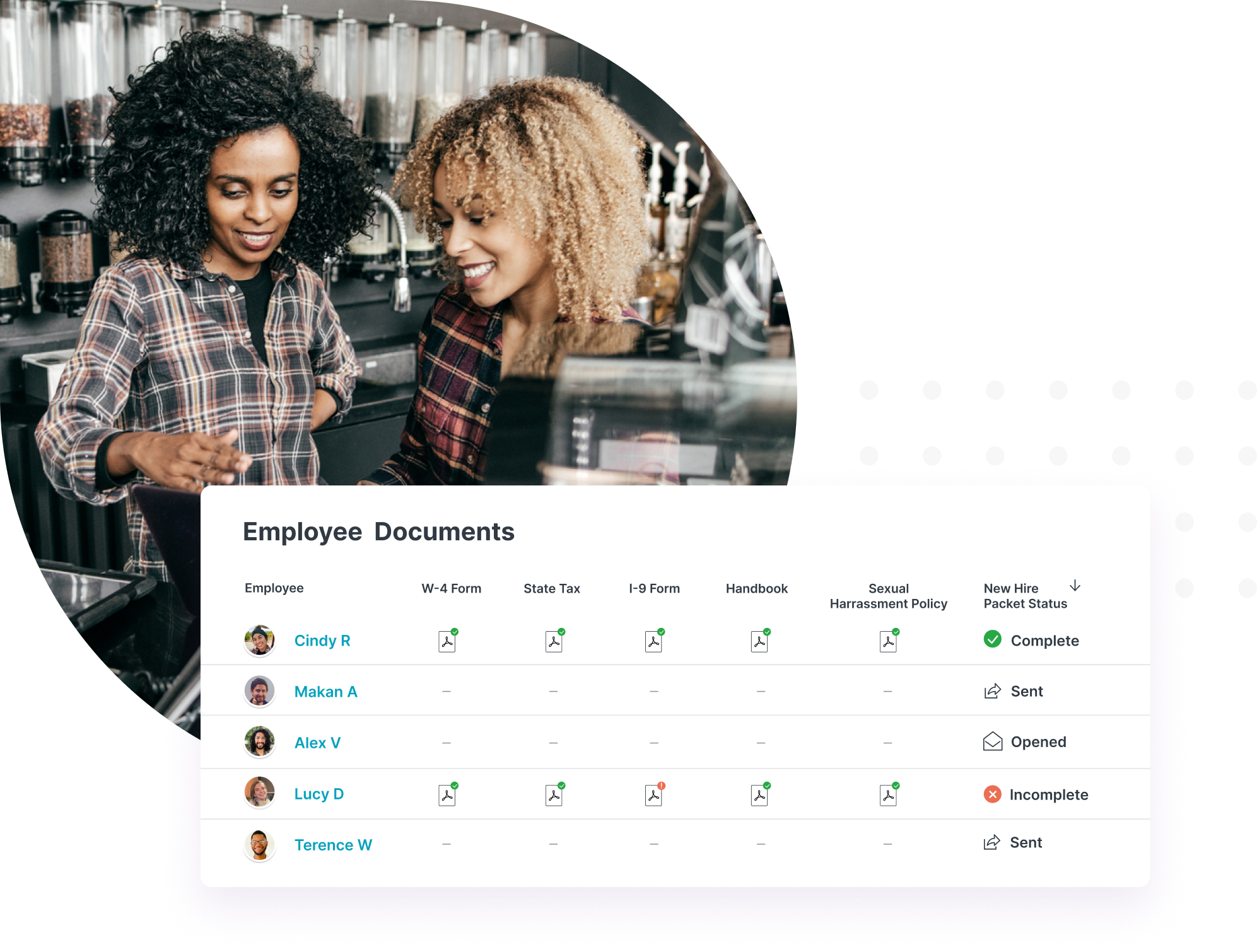The restaurant business comes with a lot of responsibilities and distractions. Even if you’re an owner or manager, you probably have to get your hands dirty and cook, clean, and bus tables alongside your employees on a regular basis.
That makes it easy to let administrative tasks, HR matters, and even restaurant compliance concerns fall by the wayside.
But what is restaurant compliance, and what are the rules and regulations restaurants actually need to know?
Restaurant compliance includes food safety and handling regulations, injury prevention, and labor laws that aim to keep your team — and your customers — safe and happy. It’s also important for keeping your business reputation intact.
We broke down what you need to know about restaurant regulations and compliance. We also included some practical tips to help you avoid compliance risks and violations. So, grab your notepad and pen, and let’s dig in!
Remember that this information is not legal advice. When in doubt, always consult an employment attorney with your specific questions about labor law compliance and consequences.

What is restaurant compliance?
Restaurant compliance is adherence to local, state, and federal codes, regulations, and safety standards that govern the way restaurant owners and operators run their businesses. On top of food safety, it also encompasses compliance with labor laws, payroll practices, OSHA (Occupational Safety and Health Administration) regulations, and even EEOC (Equal Employment Opportunity Commission) guidelines.
Why are there government regulations for restaurants?
There are a few reasons why federal, state, and local government regulations for restaurants exist:
- Food safety and public health: Regulators rely on the FDA’s (Food and Drug Administration) Food Code recommendations to make sure that restaurants promote safe food handling practices and prevent the spread of foodborne illnesses.
- Fair labor practices: The Department of Labor’s FLSA (Fair Labor Standards Act) ensures that restaurant owners follow federal, state, and local standards for minimum wage, overtime hours, and hiring workers under 18.
- Safe work environments: Working with food can be risky, and owners have to follow OSHA safety regulations to make sure they’re creating healthy, hazard-free work environments for their staff.
- Inclusive workplaces: The EEOC works to educate employers and employees about workplace discrimination. They also investigate any complaints of discrimination based on race, color, religion, sex (including pregnancy, gender identity, and sexual orientation), national origin, disability, age (40 or older), or genetic information.
Restaurant compliance rules checklist
With so many compliance rules and government regulations to satisfy in the food service industry, restaurant owners, managers, and staff need proper training and processes in place to stay compliant.
Have a cleaning policy
While a cleaning policy sounds obvious, restaurateurs and staff don’t always know the specific cleaning violations that health and safety inspectors look out for — and see all the time. Keep a food safety and cleaning checklist somewhere your restaurant staff can review, and make sure it’s consistent with your own restaurant’s policies.
It should include detailed cleaning and handling procedures for:
- Personal hygiene
- Proper food preparation
- Hot holding
- Cold holding
- Refrigerator, freezer, and milk cooler
- Food storage and dry storage
- Cleaning and sanitizing
- Utensils and equipment
- Large equipment
- Garbage storage and disposal
- Pest control
Conduct regular deep cleaning
Restaurant cleaning is a big part of standard day-to-day operations. To stay on top of all your tasks, create a master cleaning schedule that lays out exactly how often certain cleaning should be done. For example, clean your floors daily, but you can clean your exhaust hoods once a week or once a month.
Other compliance areas for weekly or monthly deep cleaning could include:
- Grease traps and exhaust fans
- Floor mats and floors
- Walls and ceilings
- Appliances and kitchen equipment, like soda fountain nozzles, meat slicers, or ice machines
- Filters
- Sinks and countertops
- Outdoor garbage
- Under and behind kitchen equipment
- Fans and lighting
Updated food handler licenses
Depending on your state and county, restaurant employees may be required to have food handler licenses or even food manager certifications, which are often reserved for supervisors.
In California, for example, any employee who prepares, stores, or serves food has to pass a food handler safety training course, complete an exam, and get a California Food Handler (CFH) card that’s valid for 3 years. Riverside, San Bernardino, and San Diego counties have their own food handler card programs, though, so CFH cards aren’t valid in those areas.
Create worker injury prevention policies
Restaurant compliance also includes attention to safety measures to prevent workplace accidents like employee falls, cuts, and burns. To avoid worker injuries and OSHA violations, your worker injury prevention measures should cover:
- Floors and walking surfaces
- Ladder safety
- Storage rooms and walk-in coolers and freezers
- Material handling
- Equipment and appliance safety
- Chemical safety
- Electrical equipment
- Fire safety
Just like your cleaning policy, your injury prevention policies should also include detailed checklists for regular staff reference.
What are some restaurant regulation requirements?
While restaurant regulations can feel overwhelming, they exist to ensure restaurant owners take care of their workers, comply with food safety recommendations, and keep their licenses and certifications up to date — that means staying busy and keeping doors open.
Be sure to consider these notable restaurant regulations for your to-do lists:
Labor compliance and restaurant employment laws
We know restaurant work comes with unique challenges around tipping, compensation, worker safety, and employee management. Indeed, operating a compliant restaurant business means knowing your responsibilities regarding:
- Wage laws: The FLSA requires non-tipped employees to be paid a minimum wage of $7.25, and tipped employees have to be paid a minimum of $2.13. That amount varies by state, though. For example, Alaska requires employers to pay workers the minimum state wage of $10.34. In California, you’re required to pay workers $14.00 if you have a maximum of 25 employees and $15.00 if you have a minimum of 26 employees.
- Tip laws: Employers can claim a maximum ‘tip credit’ of $5.12 from employees who make at least $30 in tips per month. They don’t deduct that amount from a worker’s tips, but they do claim a percentage of tips to cover their obligation to pay minimum wage.
- Overtime laws: The FLSA requires overtime pay for hourly employees who work over 40 hours per week. Employers calculate an employee’s overtime pay rate by multiplying the employee’s hourly wage by 1.5. This can also vary by state, like in Nevada and Alaska, where employees can get overtime pay if they work over 8 hours in a day.
- Worker safety laws: OSHA requirements for restaurants are just like those for other potentially hazardous workplaces. OSHA requires that employers display a clearly visible poster educating employees on their rights under the OSH Act — including the right to report a violation without fear of retaliation. Employers are also obligated to report serious injuries to OSHA within 8 hours of occurrence, and they have to keep reports of any workplace accidents and injuries updated and accurate. In the case of a workplace injury, restaurant employees may also be legally entitled to Workers Compensation benefits.
- Anti-discrimination laws: According to the EEOC and Title VII of the Civil Rights Act, it’s illegal for employers to make any kind of workplace decision based on race, color, religion, sex (including gender identity, sexual orientation, and pregnancy), national origin, age (40 or older), disability or genetic information. This includes employer decisions about recruiting, hiring, pay, promotions, references, and restaurant staff training.

Food safety and food handling regulations
Did you know that health and safety inspectors make restaurant inspection records available to the public? You don’t want your local customers reading about your violations, so you can’t cut corners on food safety and food handling.
Here’s a non-exhaustive list of regulations for reference:
- Make sure signs are displayed where employees can see them, such as your “All employees must wash hands” sign in the bathroom.
- Be careful of cross-contamination. For example, it’s against health codes to use the same utensils to cut raw chicken and vegetables without sanitizing them in between.
- Monitor your time and temperature control issues. Never leave foods out that should be refrigerated or frozen.
- Store your refrigerated food properly. Raw and cooked vegetables should be on top in your refrigerator, with cooked meats underneath, then raw meats further down, and poultry at the very bottom.
- Train your employees about hygiene. Staff should wear hairnets if necessary, keep their uniforms clean, and learn best practices for when and how to wash their hands.
Staff conduct
Restaurants can be bustling, high-pressure environments that exacerbate inappropriate behavior, but they don’t have to be. Make sure you educate train, educate, and reinforce your employee conduct policies and make it clear you have a zero-tolerance policy for:
- Harassment: Any kind of discrimination that violates Title VII of the Civil Rights Act, the Age Discrimination in Employment Act, and the Americans with Disabilities Act. It can include conduct such as “offensive jokes, slurs, epithets or name-calling, physical assaults or threats, intimidation, ridicule or mockery, insults or put-downs, offensive objects or pictures, and interference with work performance” or any behavior that creates an intimidating or hostile environment.
- Sexual harassment: According to the Department of Labor, there are two kinds of sexual harassment — quid pro quo (“this for that”) harassment, when an employment decision is made in exchange for unwelcome sexual favors or advances, and hostile work environment harassment, which is unwelcome sexual conduct or behavior from coworkers or superiors.
Alcohol sales
Alcohol sales are a great way for restaurants to bring in extra revenue. But restaurant alcohol regulations vary a great deal according to your state and county.
For example, Kansas, Mississippi, and Tennessee are all technically “dry states” where every county has to legalize liquor licenses and the sale of alcohol, and many dry counties still exist in Arkansas, Georgia, Kansas, Kentucky, Tennessee, South Dakota, and Texas.
Tips to avoid restaurant compliance risks
Now that we’ve talked about compliance, what can restaurant owners do about it? Let’s look at some ways you can educate yourself and your employees about compliance.
Talk to a lawyer
Talking to a lawyer who specializes in business law can help you prevent non-compliance issues before they happen. Lawyers have specialties, though, and even business lawyers sometimes specialize down even further in specific areas.
If compliance is your number one concern, it’s a good idea to research law firms and lawyers who specialize in:
- Small business law
- Employment law
- Fair trade practices
- Business litigation
- Risk and compliance law
Have clear policies in place
Your restaurant employees should know that you have clear policies in place regarding wages, hours, food safety, worker safety, and anti-discrimination from day one.
We recommend putting all of your policies together in an easy-to-read employee handbook that also explains your restaurant’s workplace philosophy. Don’t forget to include a disclaimer that your handbook is not an employment contract. An employee handbook is not legally binding in the same way that a contract is, and it can be updated at any time.
If you need help with your employee handbook, Homebase HR Pro has your back. When you sign up, you’ll get live access to expert advisors who can review your current policies and help write new ones.
Hire the right people
Ideal restaurant staff don’t just have front-of-house or back-of-house experience. They know how to deal with the specific challenges that come along with working in a restaurant and understand they’re the faces customers associate most strongly with the business.
Hiring the right restaurant employees means getting detailed with your job descriptions, applicant screening questions, and interview questions so you find competent and positive employees who understand the importance of compliance.
Proper onboarding and training

You can start onboarding before a new hire’s first day by having them read and e-sign any necessary new hire paperwork and packets as soon as you offer them the job — which, by the way, you can do when onboarding with Homebase’s mobile app. That way, you can spend time on your employee’s first day educating them on important matters like restaurant compliance.
Training employees on food and work safety is a lengthy process, but you can give them an overview of how everything works during their first week and make it clear they’re learning experience is a priority.
Create a great work culture
A positive work culture can have a powerful impact on employee effectiveness, and creating a safe environment free of discrimination and harassment should always be a priority. You want your employees to feel safe and respected in their workplace, and not afraid to come to work. [add].
When you take the time to educate your workers on the restaurant compliance issues that matter, and you’re telling them their growth and development matter because you’re giving them knowledge they can bring into a future career in the restaurant industry.
Check state and local laws
State and local laws can change from year to year, and you might feel like you can’t keep up with all the updates and regulatory agencies that expect you to have the latest information.
We created our state labor law hub for small business owners so you don’t have to do deep Google research on your own — now you have a go-to database for that.
Keep your restaurant compliant with Homebase

You don’t have to keep all the information we covered in this article saved on an Excel spreadsheet, and you definitely don’t have to work on compliance issues alone.
Homebase came to life to help small business owners manage HR and compliance, hiring and onboarding, timesheets, payroll, and team communication all in one place without having to outsource to professionals or juggle a bunch of complicated tools.
Best of all, Homebase HR lets you automate your restaurant compliance process so you have more time to focus on what really matters — growing your business.
Restaurant compliance FAQs

Why are regulations necessary in the restaurant industry?
Regulations are necessary so that there’s a standardized and comprehensive way to monitor and promote food safety and avoid food-borne illnesses in the restaurant industry. Restaurant compliance regulations are based on the FDA’s Food Code recommendations, which local, state, tribal, and federal regulators use to guide their own food safety rules to stay consistent with national food regulations.
What is restaurant compliance?
Restaurant compliance is following regulatory guidelines for restaurants at the local, state, and federal levels. And it’s not just about food safety — restaurant compliance covers everything from legal labor and payroll practices to OSHA (Occupational Safety and Health Administration) and EEOC (Equal Employment Opportunity Commission) adherence.
What are some common violations of restaurant standards?
Here are some common restaurant health code violations that unannounced health and safety inspectors often cite:
- Missing/poorly displayed signs and posters, such as signs that enforce employee handwashing.
- Poor personal hygiene, such as failing to wash hands.
- Cross-contamination, like using the same utensils to cut raw chicken and vegetables without sanitizing them.
- Time and temperature control issues, such as leaving out foods that should be frozen or refrigerated.
- Improper food temperature, such as failing to monitor the temperature of fridges and/or freezers.
- Lack of PPE (personal protective equipment) or PPE worn improperly.
- Improper handling or storage of service ware, such as failing to store cups upside down to avoid bacterial contamination.
- Improper use of cleaning supplies, such as using the wrong cleaning solutions to disinfect surfaces.
- Storing expired foods.
- Inadequate pest control.

